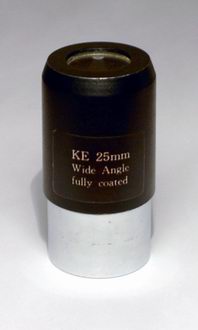Eyepiece
(Redirected from Ramsden eyepiece)
Eyepiece is an optical component that is attached to a variety of optical devices such as telescopes, microscopes, and binoculars. Its primary function is to magnify the image formed by the device's objective lens or mirror. By doing so, it allows the user to view details of the observed object with greater clarity and resolution. The eyepiece is positioned at the end of the optical instrument closest to the user's eye, hence its name.
Design and Function[edit | edit source]
The design of an eyepiece involves a combination of lenses arranged in a specific configuration to correct for various optical aberrations while providing a comfortable viewing experience. The most common types of eyepiece designs include the Ramsden eyepiece, Huygens eyepiece, Orthoscopic eyepiece, Plossl eyepiece, and Barlow lens which is often used in conjunction with other eyepiece types to increase magnification.
Each design has its own set of advantages and is suited for different types of observations. For example, the Plossl eyepiece is popular among amateur astronomers for its wide field of view and good eye relief, while the Orthoscopic eyepiece is favored for lunar and planetary observations due to its sharpness and high contrast.
Magnification[edit | edit source]
The magnification provided by an eyepiece is determined by its focal length. The shorter the focal length of the eyepiece, the higher the magnification. Magnification is calculated by dividing the focal length of the telescope's objective lens or mirror by the focal length of the eyepiece. This relationship allows users to switch eyepieces to achieve different magnifications for observing various celestial or microscopic objects.
Field of View[edit | edit source]
The field of view (FOV) is another important characteristic of an eyepiece. It determines the extent of the observable area at any given time. Eyepieces can have a wide field of view, which is beneficial for observing large objects or star fields, or a narrow field of view, which is better for detailed observations of smaller objects. The FOV is usually expressed in degrees.
Eye Relief[edit | edit source]
Eye relief is the distance from the last surface of an eyepiece at which the user can position their eye to see the full field of view. Longer eye relief is particularly important for users who wear glasses, as it allows them to see the entire field of view without removing their eyewear.
Usage and Compatibility[edit | edit source]
Eyepieces are interchangeable, allowing users to switch between different types and magnifications depending on the observation needs. However, it is important to note that not all eyepieces are compatible with all optical instruments. The physical mount size, often referred to as the barrel diameter, must match the eyepiece holder on the device. The most common sizes are 1.25 inches and 2 inches in diameter.
Care and Maintenance[edit | edit source]
Proper care and maintenance of eyepieces are crucial for preserving their performance and longevity. This includes regular cleaning of the lens surfaces with appropriate optical cleaning solutions and materials, as well as safe storage to protect them from dust, moisture, and mechanical damage.
Search WikiMD
Ad.Tired of being Overweight? Try W8MD's physician weight loss program.
Semaglutide (Ozempic / Wegovy and Tirzepatide (Mounjaro / Zepbound) available.
Advertise on WikiMD
|
WikiMD's Wellness Encyclopedia |
| Let Food Be Thy Medicine Medicine Thy Food - Hippocrates |
Translate this page: - East Asian
中文,
日本,
한국어,
South Asian
हिन्दी,
தமிழ்,
తెలుగు,
Urdu,
ಕನ್ನಡ,
Southeast Asian
Indonesian,
Vietnamese,
Thai,
မြန်မာဘာသာ,
বাংলা
European
español,
Deutsch,
français,
Greek,
português do Brasil,
polski,
română,
русский,
Nederlands,
norsk,
svenska,
suomi,
Italian
Middle Eastern & African
عربى,
Turkish,
Persian,
Hebrew,
Afrikaans,
isiZulu,
Kiswahili,
Other
Bulgarian,
Hungarian,
Czech,
Swedish,
മലയാളം,
मराठी,
ਪੰਜਾਬੀ,
ગુજરાતી,
Portuguese,
Ukrainian
Medical Disclaimer: WikiMD is not a substitute for professional medical advice. The information on WikiMD is provided as an information resource only, may be incorrect, outdated or misleading, and is not to be used or relied on for any diagnostic or treatment purposes. Please consult your health care provider before making any healthcare decisions or for guidance about a specific medical condition. WikiMD expressly disclaims responsibility, and shall have no liability, for any damages, loss, injury, or liability whatsoever suffered as a result of your reliance on the information contained in this site. By visiting this site you agree to the foregoing terms and conditions, which may from time to time be changed or supplemented by WikiMD. If you do not agree to the foregoing terms and conditions, you should not enter or use this site. See full disclaimer.
Credits:Most images are courtesy of Wikimedia commons, and templates, categories Wikipedia, licensed under CC BY SA or similar.
Contributors: Prab R. Tumpati, MD




